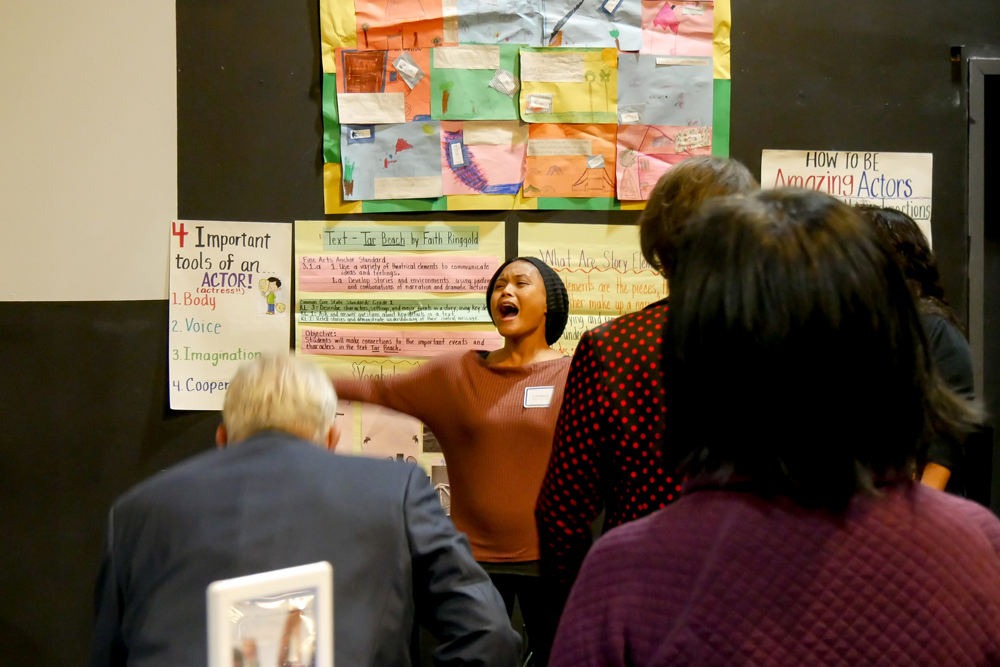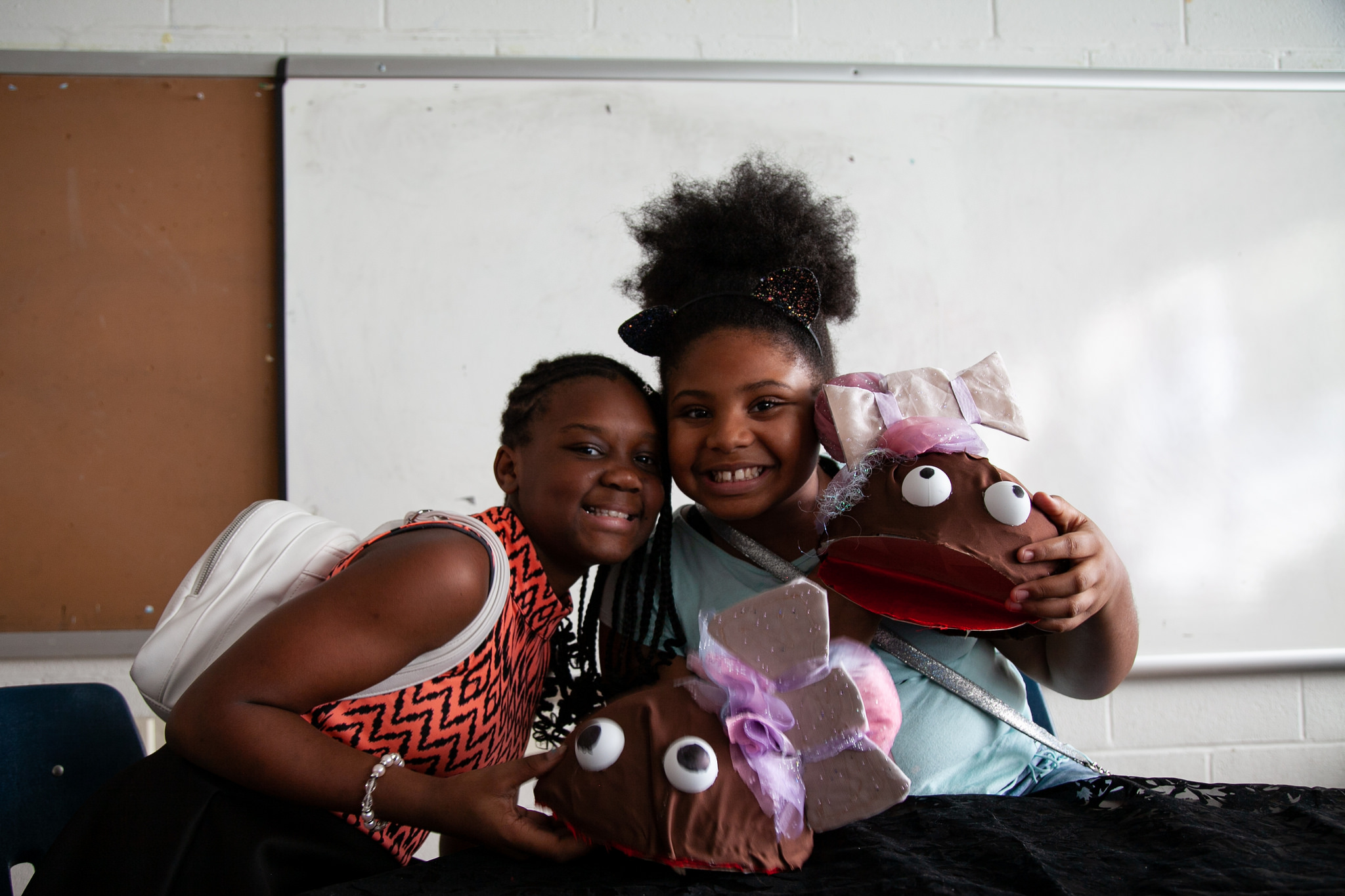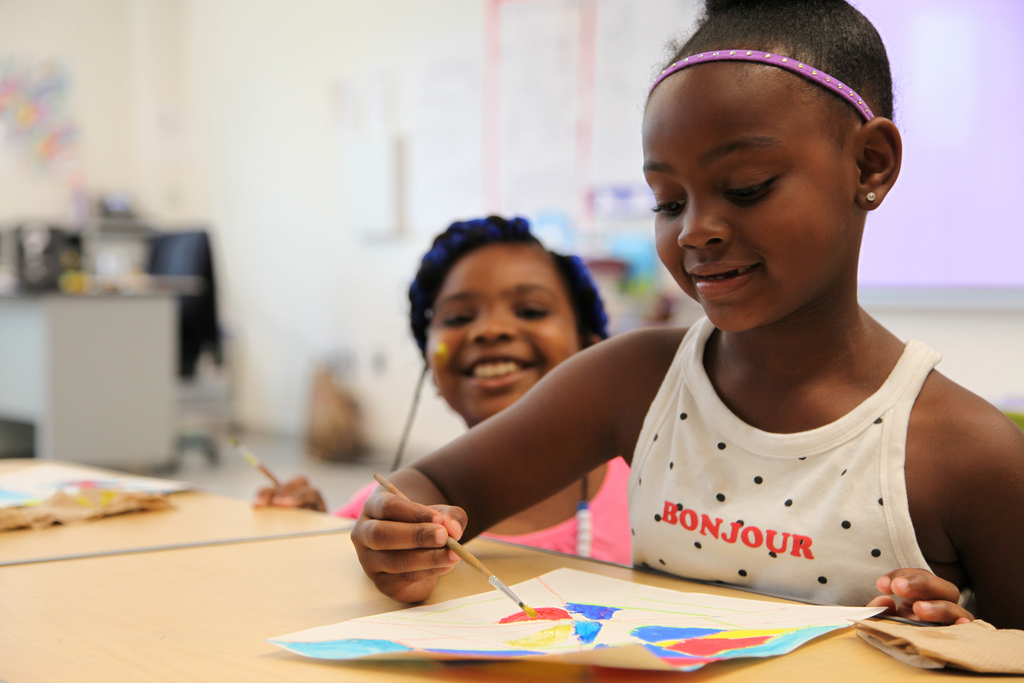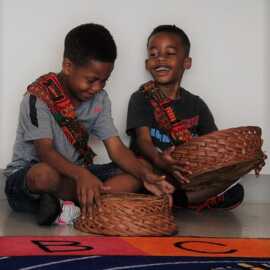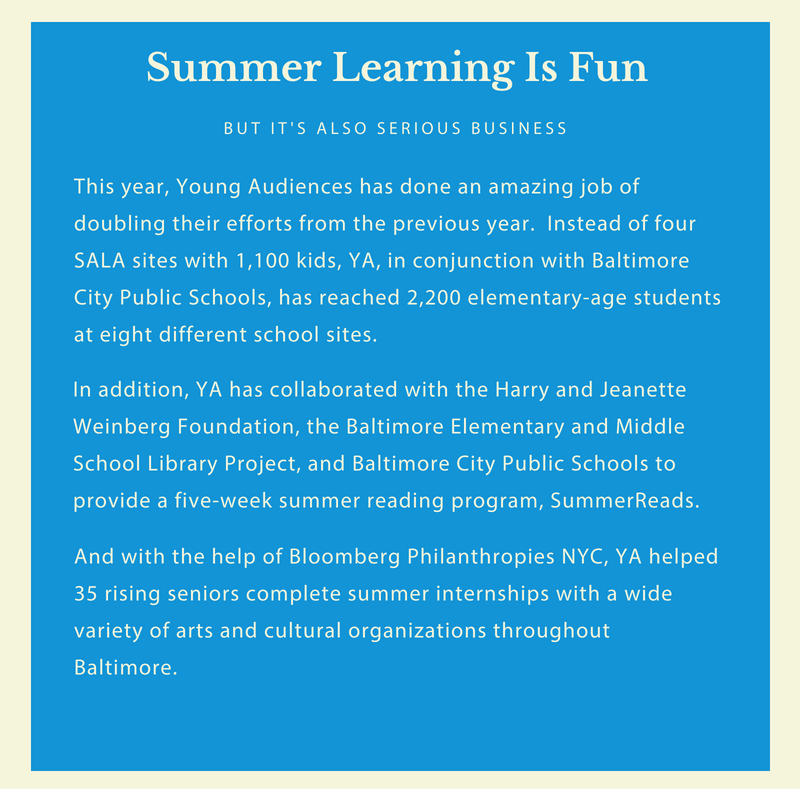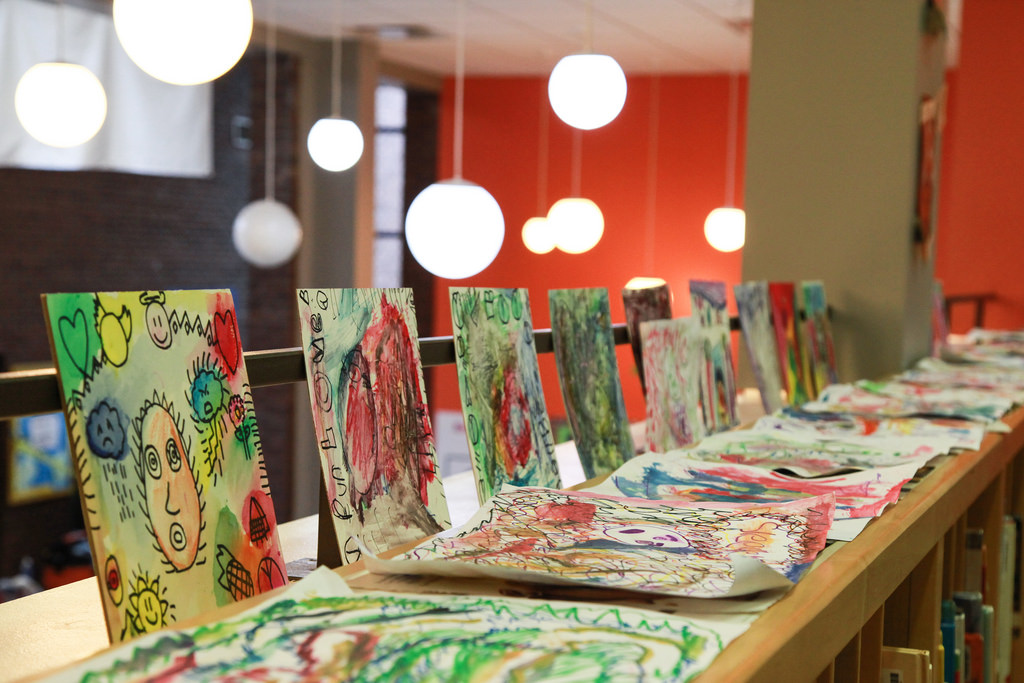Blog
Study Shows YA’s Summer Arts & Learning Academy Exceeds Expectations in Supporting Academic and Social-Emotional Growth
Students in free arts-integrated program for City Schools realize growth in math, reading, writing, and social-emotional learning – especially for those behind academically.
BALTIMORE, (February 18, 2019) – A new study shows that students who participate in Baltimore City Public Schools’ Summer Arts & Learning Academy (SALA), operated by Young Audiences, realize positive academic growth and improved social-emotional skills. The research indicates that when compared to the rest of the students in the program, students with special needs saw significantly more growth in writing and in some social emotional domains. Similarly, students that started the summer program behind in math saw significantly more growth over the summer than their peers who began the program on grade level.
The 2018 Summer Arts & Learning Academy, a free five week arts integration program for Baltimore City Schools students, was held from July 9 to August 10 at eight sites across Baltimore City. Through hands-on activities co-taught by professional artists and classroom teachers, nearly 2,200 Pre–K-5th grade students engaged in painting, songwriting, poetry, dance, music, photography, playwriting, filmmaking while learning math and literacy.
SALA students’ test scores at the beginning and end of the program were analyzed by WolfBrown, a national leader in research on arts education and children’s academic, social, and emotional development. WolfBrown’s analyses revealed increases in students’ math, reading comprehension and writing scores that were not only statistically significant, but large. On average, students’ math scores increased by 15 percentage points, their reading comprehension scores increased by 11 percentage points, and their writing scores increased by 14 to 16 percentage points.
Of particular interest in the study was the growth seen among students who were behind academically or who were at risk of falling behind. Students further behind in math at the beginning of SALA showed the largest growth in math – their test scores grew nearly 1.5 times the rate of their peers. Similar results were observed among students with IEPs. An IEP is an individualized educational plan given to students who demonstrate at least one of 13 special factors, all of which are considered to impede learning. Students with IEPs out-paced their peers in writing content score-growth by nearly 1.24 times. Students with IEPs also showed growth in self control as reported by parents.
Dr. Sonja Santelises, Baltimore City Schools CEO, said,
“We believe in educating the whole child and this summer program does just that. We are thrilled that this investment is resulting in student gains in literacy and math. Just as important, this program gives young people an opportunity to learn about and express themselves through different art forms, which ultimately strengthens empathy and other social-emotional skills in our young people.”
The Baltimore City Schools Office of Achievement and Accountability conducted its own evaluation of the program, comparing scores from end-of-academic-year standardized assessments (iReady and DIBELS) to the beginning of the year in order to measure summer learning loss and the impact of SALA in mitigating that loss. In three of the four comparisons, SALA students program showed lower rates of summer learning loss than students who were not in a summer program.
“Young Audiences’ evaluation contributes to the body of national research showing that when children have sustained opportunities to learn in and through the arts, they have greater rates of academic success,” said Stacie Sanders Evans, Young Audiences President & CEO.
“The Every Student Succeeds Act, the law that governs US public education policy, calls for greater attention on the whole child and specifically social-emotional learning, while requiring schools to adopt evidence-based practices. We hope this evidence will lead more Maryland schools to consider the arts as a vehicle for building student empathy and other life skills such as cooperation and self-management.”
As a result of the program’s continued success, Baltimore City Schools and Young Audiences will expand SALA in 2019 to Pre-K, reaching more than 230 of our City’s youngest learners across all 8 sites.
Download the full WolfBrown evaluation
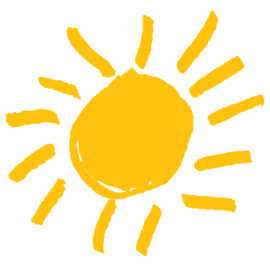
About Young Audiences/Arts for Learning
Started in Baltimore in 1950, Young Audiences is the nation’s largest arts-in- education provider. As the Maryland affiliate, Young Audiences/Arts for Learning (YA) is devoted to enriching the lives and education of Maryland’s youth through educational and culturally diverse arts programs. Through Young Audiences, professional artists from all disciplines partner with leaders and schools for nearly 10,000 hands on arts learning experiences that reach more than 190,000 Maryland students. Young Audiences envisions a Maryland where the arts are valued for their capacity to transform lives, and where every student is immersed in opportunities to imagine, to create, and to realize their full potential.
Student-Centered Summer
In January, the sun disappears so quickly—its absence makes the air that much colder. It feels funny to reflect on my youngest daughter’s first experience at Summer Arts & Learning Academy (SALA) when, outside, it feels like it just might snow.
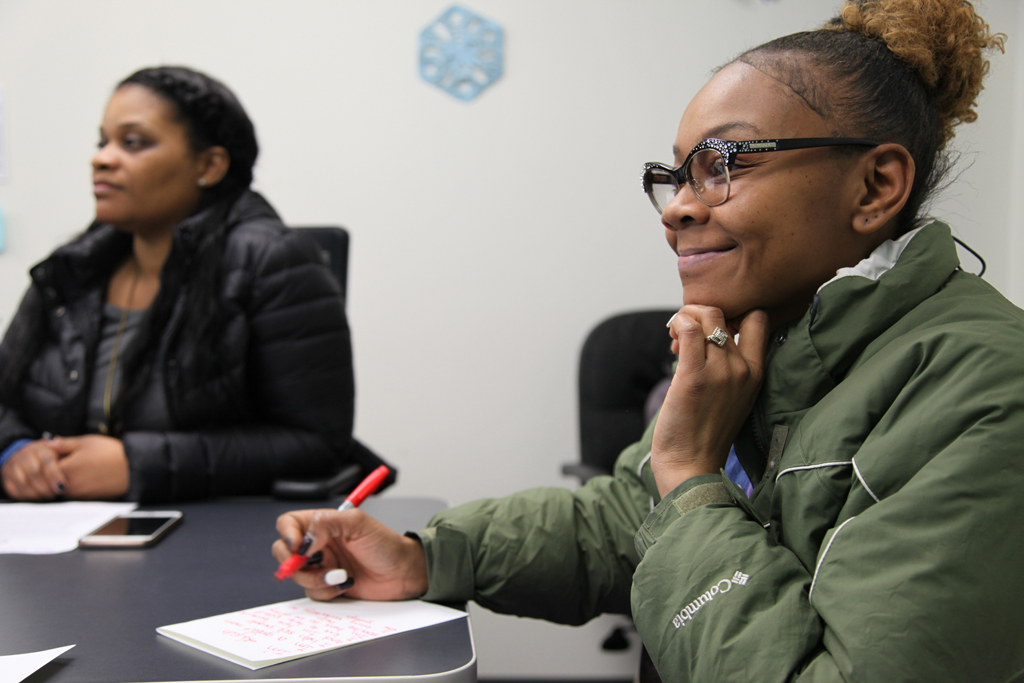
Kiyah and I, both of us parents of children who attended SALA 2018, were asked to meet at Young Audiences a couple of weeks ago. A teacher, Jesika Paige, was here, too. She wasn’t at my child’s SALA site last year, but I remember meeting her once. And I recognize her from our How We Do Summer video. Her smile is warm and her energy is radiant and it was so nice to be sitting at the table with her. Joining us were five teaching artists: Katherine Dilworth, Jamaal “Mr. Root” Collier, Vonnya Pettigrew, and Mama Kay and Mama Rashida of WombWork Productions, along with staff members Michael Brush, Monique Cox, Kurtis Donnelly, and Kristina Berdan.
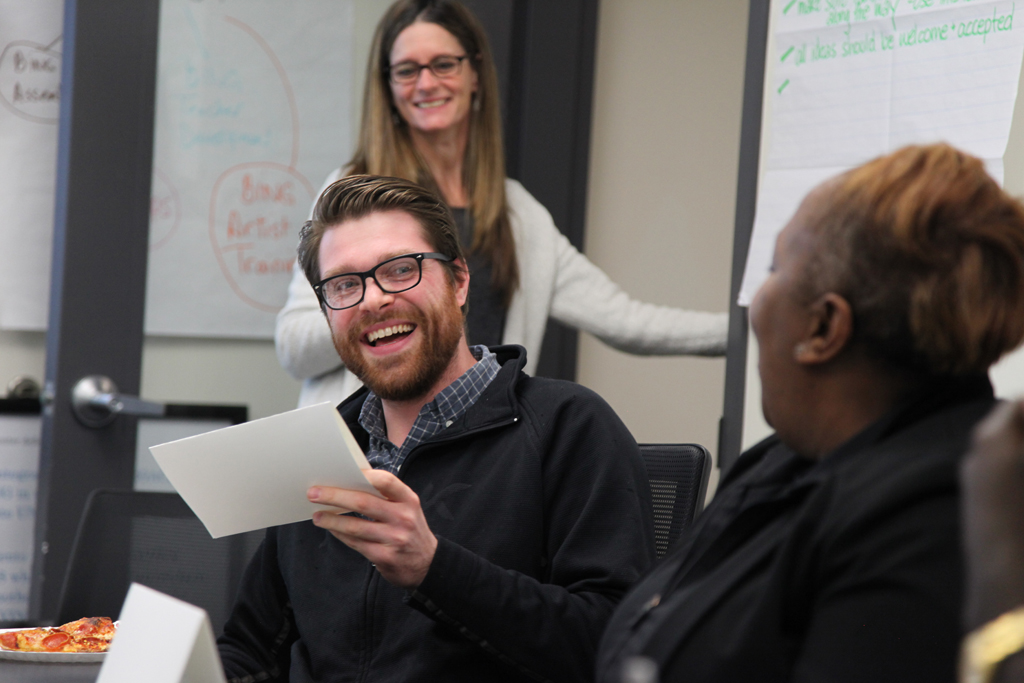
Parents love SALA for a multitude of reasons. For one, Baltimore City Public Schools students participating in SALA have not only avoided summer learning loss but, in many cases, gained ground on their national peers in standardized testing. Between this and the fact that kids in SALA are immersed in meaningful art projects every single day, enrolling my 6-year-old was an easy decision. And as Ms. Paige noted in How We Do Summer, “for children who suppress their art during the school year, this was a time for them to actually show up and show out and show their artistic ability.” So, how can we take this amazing and enriching educational experience and make it even better? This is what we are here to find out.

Something that Young Audiences always makes sure to do is collect and evaluate feedback from all of a program’s stakeholders. If you are ever asked to fill out a survey regarding one of YA’s programs, know that your comments are read, your answers to questions are carefully considered, and your voice matters. The idea to form a community advisory for SALA was brought about in the feedback we collected from parents, and from students, teachers, and artists. Our mission is to ensure that SALA (an incredible, free, arts-filled, and academically excellent program) is student-centered and to identify program changes and improvements to implement during SALA 2019.
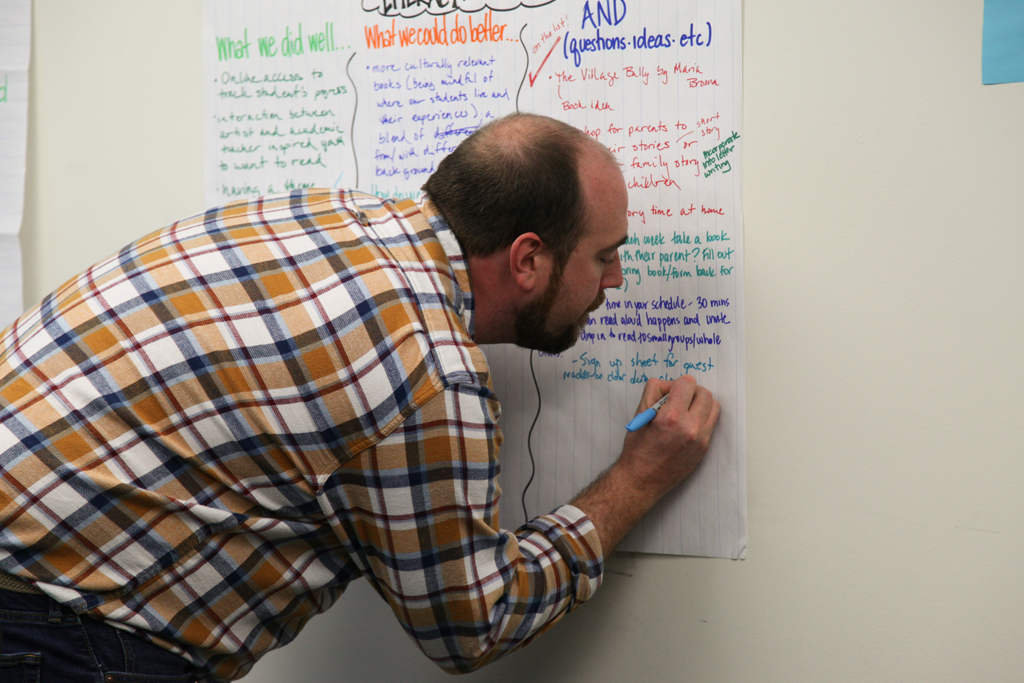
Coming together with other stakeholders for the SALA Community Advisory’s inaugural meeting reiterated to me the desire of everyone involved to improve, and to be wise, and strong. The group committed to making sure all families are involved all along the way and that all ideas are welcome. We look forward to sharing and listening with open hearts and open minds, reflecting on what we did well in 2018, what we can do better, on ideas for the future, and welcoming the unexpected. We cannot wait for another summer of SALA, each one better than the last—in the meantime, let it snow. Written by Shannon Kline, parent and Young Audiences Communications Associate.
If you would like to be a part of the Summer Arts & Learning Academy (SALA) Community Advisory, we invite you to contact Kurtis Donnelly at [email protected]. Your thoughtful input helps to make our programs the very best for students and we appreciate your time and dedication.
A Saturday Morning Tunes Giveaway!
Thanks to our smARTbeats partners, WTMD, we have five Family Four-Packs for the Saturday Morning Tunes Grateful Dead tribute show with Ed Hough’s Dead Collective to give away! That means five of our lucky Facebook followers will receive four tickets each to the SOLD-OUT 9:30 a.m. show at the American Visionary Art Museum on Saturday, February 2, 2019!
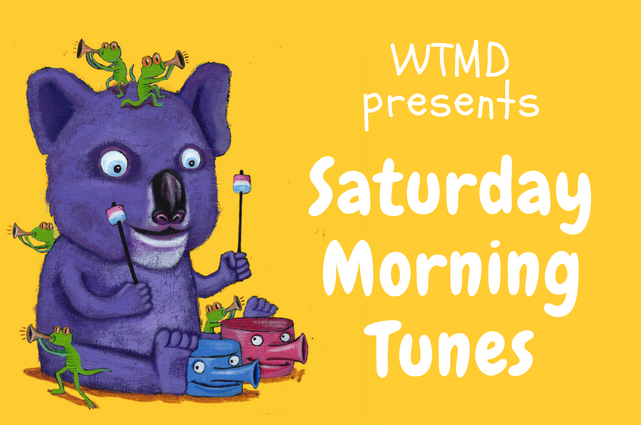
Grateful Dead fans with young kids won’t want to miss out on the chance to attend this sold-out event! Ed Hough’s Dead Collective, who are some of Baltimore’s best roots and Americana musicians, will be channelling the music of the Grateful Dead in AVAM’s banquet hall among the museum’s renowned colorful and engaging artwork. Tickets also include organic snacks and juice for kids and coffee for adults. Doors open at 9 a.m., and the show runs 9:30 a.m.-10:30 a.m.
Many thanks to WTMD for sharing this amazing opportunity! This contest is now closed.
Inspire, Imagine, Improve!
Written by Barbara Krebs,
Young Audiences volunteer and Sunburst Society member
A few weeks ago, I was happy to attend Young Audiences’ third Art Crawl, held this year at the Single Carrot Theatre adjacent to YA’s offices.
For those of you who have not attended this annual event, I highly encourage you to do so. First of all, you’ll get to party with a group of fun, interesting, entertaining and dedicated folks. Secondly, you’ll get to enjoy the learning environment presented to the kids who attend YA’s Summer Arts & Learning Academy (SALA). And by that, I mean you’ll act, play music and create artwork, which helps you understand your reading assignment or your math homework. And finally, you get to nosh on great hors-d’oeuvres and sip handcrafted cocktails created by some of YA’s board members!

As always, I find myself splitting my time between talking to people I’ve met in the past, and meeting new folks who have interesting stories to tell. This time was no different. Balancing a plate of delicious appetizers from Copper Kitchen and a glass of wine provided by North Charles Fine Wine & Spirits, my husband and I soon found an empty spot at a table and introduced ourselves to Cori Daniel and Carlotta Williams. Turns out they were actually a teaching artist/teacher team who would later explore the book, Tar Beach, a story by artist Faith Ringgold recalling the dream adventure of a young girl flying high above her neighborhood in 1939 Harlem.
No matter the genre, the goal is making sure the children stay focused on the subject matter, sneakily presented as a lot of fun.
But I didn’t know this yet. What I did find out though was how long they had been teaching, what they taught, and I got to observe their obvious enthusiasm for the children and learning. Their animated conversation about their SALA classroom was fascinating, as were their fond memories of inspiring kids to learn while the children used their imaginations to improve their reading scores.
Oh, did I just use inspire, imagine and improve in one sentence? Yes, I did, and that is, of course, no accident. Having witnessed teachers and children in action in several of SALA’s classrooms this summer, and getting a chance to actually engage in it myself during Art Crawl is to truly understand how those three words create an arts-integrated learning environment that SALA uses to stem summer learning loss and bridge the Inspiration Gap.

In SALA’s five-week summer classrooms, kids use a wide variety of art techniques to help them master core subjects – whether it’s textile art to illustrate a story they are studying or rapping their multiplication tables or dancing to show character development. No matter the genre, the goal is making sure the children stay focused on the subject matter, sneakily presented as a lot of fun.
And so it was. In the segment taught by the second-grade teacher and teaching artist I had just met, we warmed up with some dance movements to highlight acting concepts. Then we looked at the pictures in the book and explained what we saw in them. Finally, we paired off and used our imaginations to explore a special place for us – one that made us feel warm and welcomed.
Next up was a math segment, guided by teaching artist Nadia Rea Morales and teacher Jose Hernandez. With a chart in the room illustrating ones as yellow, tens as red, and hundreds as blue, I created a Piet Mondrian “masterpiece.” The focus was to teach second-graders their ones, tens, and hundreds places and the relationships between digits and their place value. My own memory of learning such things was of boring, rote exercises that left me cold. Here, I hadn’t had so much fun with scissors and construction paper in ages. And to think – I was learning math!

I ended the evening with teaching artist Christina Cook, who was surrounded by a variety of percussion instruments. As she demonstrated how these were used to sound out the syllables in words, I noticed how she was combining both math and vocabulary – a certain number of syllables to express a phrase, as she beat the rhythm on her drum. She then handed out instruments and instructed us to follow along.
In addition, she said she used this technique to help the pre-K kids she taught to express their emotions. At first, she told us that the students mostly stuck to “happy” or “sad,” but soon she noticed that, as the kids gained confidence with the percussion pieces, their emotional range expanded, too. Now they were “curious” and “frustrated” and “ecstatic.” She admitted that she was impressed with the varying emotions the kids conveyed as well as the fact that they already had the vocabulary to communicate it. They had only needed the little nudge the music gave them to open up and express themselves more fully.

I have to admit – Inspire, Imagine, Improve is a mantra I can really get behind. Because each time I’ve attended Art Crawl, I come away inspired by all the people who donate time, expertise and/or money to make SALA a reality for 2,100 elementary school-age kids. I can only imagine how much harder it would be for the children and their teachers if this summer program didn’t exist. And I know that Young Audiences’ aim to improve test scores and access to arts-integrated learning is something I’m behind 100 percent.
Wouldn’t you like a little Inspire, Imagine, Improve in your life? Come join us next year and I think you’ll find your own stories of imagination that inspire you to improve. Until then, Happy Holidays!
Smart Growth: Onward in Unison
Have you noticed how much we’re growing? Our staff is now 29 people strong! That collective energy is felt every day, but it really blew us all away as new and veteran staff sang together at the start of our annual retreat. Some of us were just getting to know everyone—one of us was meeting everyone for the very first time that day— and all of us grateful for the time together. As you may well know, at Young Audiences, we start with the art! The group split into sections and sang one of three traditional gospel hymns, each individually powerful. When sung together as a medley, though, the three hymns created an entirely new force.

Over the summer, we created two new Teaching Artist Fellow positions within the organization and welcomed Katherine Dilworth and Valerie Branch into the role! Both Katherine and Valerie are highly skilled in teaching artistry and have been delivering arts-integrated instruction and teacher professional development with Young Audiences for years. In addition to continuing their fantastic work in the schools as teaching artists, they will also serve in an expanded capacity by consulting with school districts and partners on arts integration strategies and practice, leading PDs, and mentoring other Teaching Artists.
“I really love being in this new position at YA. I love that I have the opportunity to grow as an artist and hone in on my skills as a mentor and Master Teaching Artist,” said Valerie — who will be doing a lot of work in Prince George’s County, including professional development and training teachers as part of their new Arts Integration Master Teacher training program. “I am excited for all of the continued possibilities that lie ahead and am looking forward to getting into the classroom this school year!”
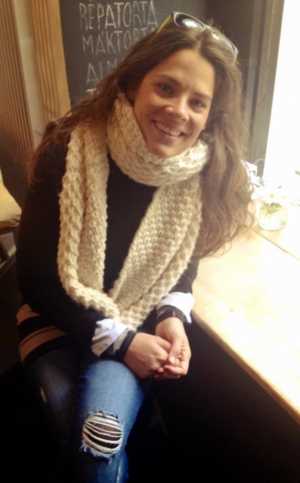
Nel Andrews is officially our new Chief Operating Officer. She comes to us from the Annie E. Casey Foundation, where she worked for the last 10 years in their Center for Systems Innovation. She has a passion for racial equity, organizational development, and systems change. We are thrilled to have her join our family! We also welcomed Arnold Joo to the brand new Data and Systems Manager position and promoted Michael Brush to Summer Arts & Learning Academy Regional Director. To top it all off, three new program coordinators have joined the staff and settled right in: Kerrigan Dougherty, Alex Crockett, and Cori Gill.
“We couldn’t be more proud of our growth and all of the hardworking and passionate people we are working with on this journey,” said Young Audiences President & CEO Stacie Sanders Evans. “We are everyday people committed to transforming education through the arts. We have enormous respect for our teaching artists and such love for our communities.” And while we are a growing organization of many parts, we work in sync, moving forward together— a medley of many parts reverberating, energizing, elevating, working to realize our mission: that one day, every student in Maryland will have the opportunity to imagine, create, and realize their full potential through the arts.
smARTbeats with Jason Baker of Fractal Cat
smARTbeats returns to WTMD on Saturday, November 10 during the weekly children’s program Young At Heart! On this month’s segment, host Lisa Mathews talks with Jason Baker, one of our talented teaching artists from Summer Arts & Learning Academy (SALA). Jason is a board-certified music therapist and teaching artist by day. Kids lucky enough to have had him as their teacher in SALA over the past few summers will tell you he has a lot of wisdom and kindness to share. Do they even know that Jason is a bona fide rocker once the day is done?
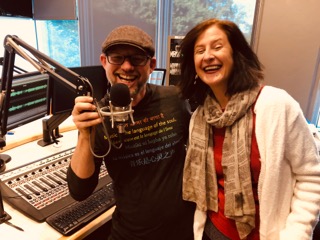
In the classroom, Jason is known as a man who helps kids learn their math facts through writing their own beatbox riffs, who models compassion and collaboration, and who leads young percussionists with artistic excellence. No doubt, the same skills he uses as a music therapist cross over into his lessons. His students work diligently, checking their numbers and planning their beats in the arts-integrated math class. The kids are eager to support their peers as each finds the courage to perform their beatbox compositions at the mic.
Jason’s music majors exhibit the same cooperation and camaraderie as his math students. They don’t just play their instruments. With their drums in a circle, the young percussionists listen, they watch, they respond to one another. Their rhythm is alive and has a personality all its own.
By night, Jason Baker is the drummer for the highly acclaimed psychedelic rock band Fractal Cat. The classically trained musician’s beats are the pulse of Fractal Cat’s euphonic sound —and like a teacher in a classroom, he keeps the music rolling.
Young At Heart airs weekly on 89.7 WTMD from 7 to 8 am on Saturdays, featuring music that appeals to parents and children alike. Previous shows have featured music by Wilco, David Bowie, Andrew & Polly, Weezer, and others.
Hear Jason Baker’s smARTbeats interview online now!
A Contemporary Armillary Sphere for the Community
Chesapeake Arts Center (CAC) Resident Artist and UMBC Visual Arts Professor Stephen Bradley’s work spans many disciplines. His art explores our relationship to place through ambient sound recordings, landscape photography, and recorded stories juxtaposed with artifacts discarded or lost in the landscape. The location- the place- where his most recent artwork, Community Connection Sculpture, is installed reaffirms the importance and connection we have with certain locations and challenges us to consider how our relationships and interactions with a place can impact its- and our – future.
As the center of community in Northern Anne Arundel County, the Chesapeake Arts Center serves to excite, educate, engage, inspire, and grow through performances, exhibitions, classes, and collaborations with artists, educators, business and community leaders, and organizations. Welcoming students of all ages through its doors every day, it is only fitting that this meeting, gathering, and growing space is now home to a large metal Armillary Sphere created by the artist with Ricky Siegert at Inferno Design and Charles Pennington. It stands at the entrance of the CAC, reminiscent of an artifact from the past, inspiring wonder and kindling ingenuity. Bradley shared some details about the artwork and what it represents for the community.
Community Connection Sculpture – Honoring the Past, Embracing our Future.
The public sculpture symbolizes an optimistic and innovative future created through the union of the arts and technology that serves the local community. Historically, CAC has been one of the few open spaces in the area for creative exploration. CAC offers ceramics, theatre, music, dance, painting and other related arts, including exhibitions and performances. Today, CAC offers its newest facility to community residents with the launch of a contemporary MakerSpace. Classes are available for those who seek to become certified in order to use computer-controlled tools — including those used for wood-working and light metal fabrication.
Historical armillary spheres were originally used as a way to model celestial objects, such as the sun, stars, and planets. Instead of the earth occupying its center, however, this sculpture holds a hexagonal form with an array of LED lights. The sculpture’s nucleus represents the center of CAC’s creative offerings and illuminates the building’s facade with subtle shifts of shadow and light from within its local “universe.” Its rings demarcate local points: Baltimore City, Annapolis, Curtis Bay, Brooklyn Park, Linthicum, and other significant places in the surrounding communities that CAC serves.
This contemporary version of the 2,000-year-old armillary pays homage to art and science endeavors of the past while inviting viewers to participate in a creative future dedicated to embracing arts and technology- one that values a STEAM-rich education, civic participation, and social entrepreneurial opportunities.
The Chesapeake Arts Center (CAC) is an Arts Empowered Minds Initiative (AEMI) partner along with Young Audiences of Maryland, Anne Arundel County Public Schools (AACPS), Arts Education in Maryland Schools Alliance (AEMS), The Arts Council of Anne Arundel County, University of Maryland, Baltimore County (UMBC), and Creating Communities. In addition to his art and teaching commitments, Stephen Bradley serves as an AEMI Advisory Committee member.
Arts Empowered Minds Initiative: Prioritizing Children and Learning
Written by Barbara Krebs,
Young Audiences volunteer and Sunburst Society member
It’s all about priorities. There are only 24 hours in a day, and as a busy person, you have to prioritize the most important things. I could tell that this principal really wanted to talk about the Arts Empowered Minds Initiative (AEMI), Young Audiences, and how arts-based learning was impacting his school. That’s because, despite the week-long game of telephone and email tag we played just before the start of the new school year, he kept contacting me to set up the next potential interview time. Happily, I finally connected with Rodney Walker, principal of Brooklyn Park Elementary School in Northern Anne Arundel County.
But first–what is AEMI? According to its website, it is “a collective impact initiative that utilizes the arts to improve school achievement, parent involvement, and student engagement and empathy in Northern Anne Arundel County Public Schools (AACPS).” That collective involves more than a half dozen organizations selected for, among other things, their “expertise in the arts, education, or both.”

So when I spoke to Principal Walker, I was curious as to how his school had become involved, how the partnership worked in his school, and what his observations of its impact were. Brooklyn Park Elementary had become an AEMI school about three years ago when he received info about the group from AACPS’ Central Office. When he met with AEMI staff and learned of their mission and partnerships, he knew that it would be a “natural fit” for his school. He liked the idea that it “gives kids different opportunities to expand their learning. It exposes them to different art genres and focuses on creative ways to teach core subjects.”
Over the summer, Principal Walker attended one of Young Audiences’ tours of Summer Arts & Learning Academy (SALA), which was specifically geared towards introducing principals to the program. Having toured SALA earlier in the summer myself, I wondered how his experience as an educator differed from mine.
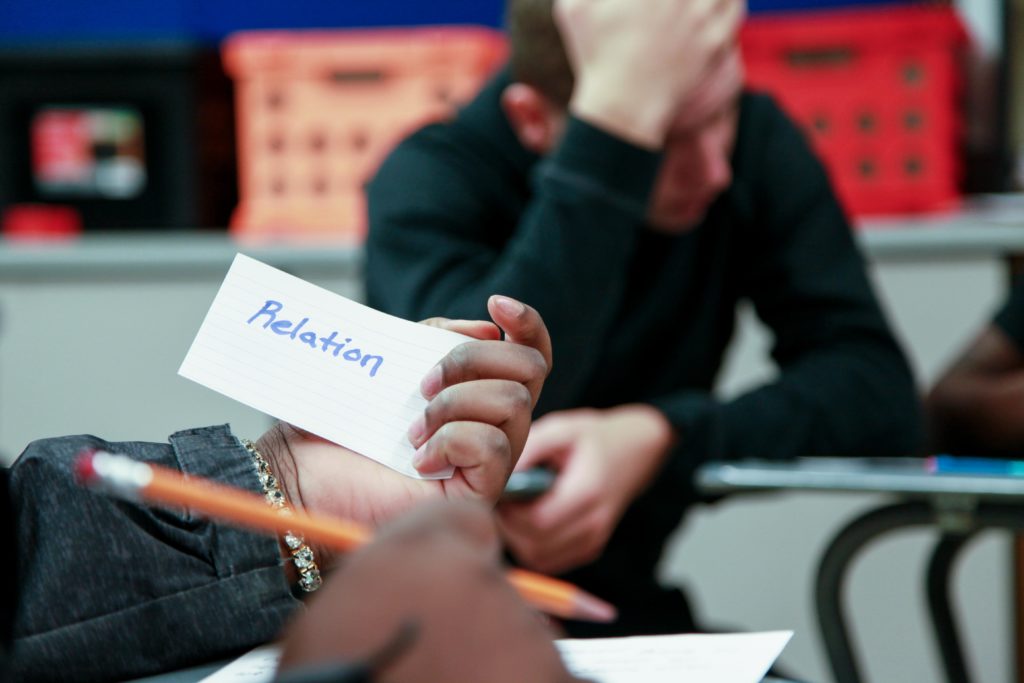
Like me, he was impressed with the fourth-grade classroom he observed using a rap song to learn math concepts. We both noticed how much fun the kids were having while they were learning, a crucial element in creating positive learning experiences.
But as a long-term educator, he noticed something that I had missed. “Sometimes our kids have difficulty in learning the math vocabulary. Here, they’re connecting because they’re having fun. But in the process, the kids are becoming leaders. They’re holding themselves accountable.” In other words, it was the children who were helping to create a positive classroom culture. Of course, the teachers were guiding it, but by empowering their students, the kids took ownership and were self-motivated.

Principal Walker’s assessment of the learning techniques he witnessed was “phenomenal,” but how will this translate back on the ground at Brooklyn Park Elementary? With AEMI’s focus on arts-based learning and its links to other arts/education groups, Principal Walker sees a continued focus on “creating a safe space for learning and exploration.”
“We will continue to work with AEMI, Young Audiences, and its partners to add professional development for our teachers, and incorporate new and creative ways to add arts-based learning into our writing and math classes.”
AEMI’s priority is to “increase access to high-quality, arts-integrated learning opportunities…” Though it’s not always easy to quantify any particular program’s impact, there is one thing that Principal Walker is absolutely certain of. That’s the “happy faces” he sees during assemblies with an arts orientation.
As Principal Walker’s enthusiasm for AEMI and its partners show, I suspect that arts-focused education will continue to be a priority at Brooklyn Park Elementary School.
The Arts Empowered Minds Initiative is the combined effort of many groups and individuals seeking to build a movement for increased equity through the arts in their community. With funding from the NEA in 2016, we built partnerships with Anne Arundel County Public Schools (AACPS), Chesapeake Arts Center (CAC), Arts Education in Maryland Schools Alliance (AEMS), Arts Council of Anne Arundel County, and University of Maryland – Baltimore County (UMBC).
Young Audiences Selected as Grantee of Bloomberg Philanthropies’ AIM Program
Young Audiences / Arts for Learning Maryland will participate in $43 million program
Young Audiences announced that it is a grantee recipient of Bloomberg Philanthropies’ Arts Innovation and Management (AIM) program. The invitation-only program seeks to strengthen the organizational capacity and programming of small and mid-size cultural organizations within Atlanta, Austin, Baltimore, Denver, New Orleans, Pittsburgh, and Washington, D.C. Through the $43 million multi-year initiative, Bloomberg Philanthropies will provide unrestricted general operating support as well as arts management training in areas that include fundraising, strategic planning, marketing, and board development.
“We’re incredibly thankful for Bloomberg Philanthropies’ support as we work to infuse and enhance student learning with hands-on arts experiences throughout Maryland,” said Stacie Sanders Evans, Young Audiences/Arts For Learning President and CEO. “This crucial funding will strengthen our organizational capacity and support all of our programs, from year-round arts-integrated classroom residencies to teacher and artist professional development.”
AIM targets arts non-profits because of the vital role that they play in building communities, driving local economies and supporting artists. “The arts inspire people, provide jobs, and strengthen communities,” said Michael R. Bloomberg, founder of Bloomberg Philanthropies. “This program is aimed at helping some of the country’s most exciting cultural organizations reach new audiences and expand their impact.”
Bloomberg Philanthropies will develop curricula and conduct seminars for the program in partnership with leading experts, including the DeVos Institute of Arts Management at the University of Maryland, led by Institute Chairman Michael M. Kaiser and President Brett Egan. AIM organizations will engage in activities that strengthen their long-term health and goals, and will receive one-on-one consultations and implementation support for organization leaders and their boards.
All organizations invited to participate in the 2018 expansion of the AIM program are nonprofits that have been in existence for at least two years. Participating organizations will be required to secure 20% of their AIM grant in matching dollars; reach 100% board participation in fundraising; and maintain up-to-date information in DataArts, an online management tool that assists arts organizations across the country in collecting, learning from, and using data effectively. The grants will be unrestricted to allow recipients to utilize the funds to address their greatest needs.
Since 2011, AIM has helped more than 500 small and mid-sized organizations in all creative disciplines, including theater, visual arts, music, film, literature and dance. Participating organizations reported significant improvements in board development, fundraising and overall income over the two-year program. Watch this video for an overview of the Arts Innovation and Management program:

About Young Audiences/Arts for Learning Maryland
Young Audiences is the nation’s largest arts-in-education provider and started in Baltimore in 1950. As a Young Audiences affiliate, Young Audiences/Arts for Learning (YA) is a nonprofit organization devoted to enriching the lives and education of Maryland’s youth through educational and culturally diverse arts programs for more than 65 years. Each year, YA reaches more than 180,000 students through over 5,000 arts learning experiences by partnering professional artists from all disciplines with schools throughout Maryland for hands-on arts learning experiences. We envision a Maryland where the arts are valued for their capacity to transform lives, and where every student is immersed in opportunities to imagine, to create, and to realize their full potential through the arts. For more information, contact YA at (855) 245-2787 or visit yamd.org.
About Bloomberg Philanthropies
Bloomberg Philanthropies works in over 480 cities in more than 120 countries around the world to ensure better, longer lives for the greatest number of people. The organization focuses on five key areas for creating lasting change: Arts, Education, Environment, Government Innovation, and Public Health. Bloomberg Philanthropies encompasses all of Michael R. Bloomberg’s charitable activities, including his foundation and his personal giving. In 2017, Bloomberg Philanthropies distributed $702 million. For more information, please visit bloomberg.org.
Arts Integration: 1 + 2 = Fun!
Written by Barbara Krebs,
Young Audiences volunteer and Sunburst Society member
When I was studying for exams in college, I would often create a strong visual image to help me remember test items. For example – the 6 C’s of credit? Character, capacity, capital, condition, collateral, cash flow. And while these concepts didn’t flow naturally through my brain, the image I created did. There was a guy (character) leaning on a crutch (condition) with a cap on (capacity) standing in front of the Capitol Dome (capital) with a briefcase (collateral) full of dollar bills (cash flow).
At the time I didn’t have a name for my study method – I just knew it worked for me. Years later I can now identify this as arts integration with an emphasis on a visual learning style.
And so I felt very at home as I toured Young Audiences’ Summer Arts & Learning Academy (SALA) at Lyndhurst Elementary/Middle School in Baltimore. That’s because each classroom was filled with young students learning in a variety of arts-integrated formats. I witnessed drama, rap songs, textile art, drawings, and writing—all used in conjunction with classwork such as a math problem or a reading assignment.
And while I knew, and the teachers knew, that these children were involved in thoughtful, hard work here—the serious business of arresting summer learning loss—the kids were focused on how much fun learning was. For example, in the PreK classroom, YA roster artist Mama Rashida of WombWork Productions and her teacher partner, Samantha Amey, worked with the students on a basic math problem: 1 + 2 = 3. Now, of course, you can force your brain to learn this by sheer rote repetition, but let’s face it. How exciting is that?
But if you illustrate it with a story about the marketplace where you must buy one fruit (fruit sellers stand here to the right!) and then move on to the vegetable stalls where you need a tomato and a carrot (veggie vendors over here, please!), you set the stage for a fun learning experience.
As the kids moved excitedly from place to place to “fill” their baskets or “sell” their wares, the teacher illustrated what they were doing on the whiteboard. With their “shopping” completed, the children returned to their seats and began to answer questions about the math problem. At this point, the teacher pretended to be confused and wrote wrong answers on the board. As the children rushed to correct her, she had them explain what was wrong, until everyone agreed that the proper answer was three.
No, this wasn’t bored voices droning “1 + 1 = 2,” “2 + 2 = 4.” Instead, these were kids excited about math, happy to supply the correct answer to a befuddled teacher and eager to learn more!
But what about English? A little later I stepped into a first-grade classroom where students were studying Charlotte’s Web. Here, I found a mix of visual art and drama being used to tell the story. Several children took turns at the front of the classroom with a drawing they had made. After displaying it, they then acted out that portion in mime. Initially, the teacher set the scene, reminding the kids what was happening in the story at this point. After the child was done, the teacher asked the other students what they had observed as their classmate portrayed the scene.
Later, I noticed a bulletin board filled with tiny spiders made using a modified papier mache technique, with pipe cleaner legs. As I looked at this, one young girl came up to me and proudly told me about the paper collages they had made to illustrate what the barnyard looked like. “They’re displayed outside the classroom. You have to see them!” Indeed, I did, and when I left, I enjoyed all the bright, cheery artwork that surrounded the door frame.
My next stop was a mixed class of second, third, and fourth graders who were working on both how to solve for an unknown number in a math problem and the nine’s in the multiplication table. And here is where I definitely appreciated the arts-integrated approach. I remember learning the nine’s and, oh, how I despised them.
But nobody seemed to hate nine’s here. Maybe that’s because as they chanted this portion of the multiplication table, not only did they give it a fun rap slant, but other classmates accompanied the song with percussion instruments. Why couldn’t they have done that when I was in school?
My final stop was to a fourth-grade classroom where the lesson was to reinforce the basic math operations: addition, subtraction, multiplication, division. Here, too, I felt very at home, but this time it was because not only did I recognize the teaching artist, YA roster artist Femi the DriFish, who I’ve witnessed teaching on several occasions, but I actually recognized kids whom I had seen before. This heightened my sense of how compelling arts-integrated learning is in capturing kids’ imaginations, so much so that they return for another summer of learning!
They rapped their way through a popular song remixed to describe math operations terms in word problems (equals to, divided by, times, added to, subtracted from, etc.) in preparation to shoot their own music video. As they practiced, I wondered what they would take away with them after this summer. Would they remember these lyrics and hum them in their head as they take a math quiz next year? Will they think about a marketplace full of vegetables and fruits and how math filled their baskets? Perhaps they’ll draw a picture that will help them recall the story they’re reading in class.
But most of all, will they remember the fun that accompanied all these math and English concepts? And that 1 + 2 = 3? I think so. And this funny little guy, leaning on his crutch with his cap, briefcase and dollar bills, standing in front of the Capitol agrees with me!

Learn more about our mission, our methods, and our future plans during a one-hour Meet Young Audiences event. In addition to hearing from the organization’s leaders and getting an inside look into the amazing work we are doing around the state, one of our roster artists will share their amazing work with you and speak about how the arts complements and enriches classroom learning. Please reach out to Ingrid Murray, Individual Giving Manager, at [email protected] for more information or call (855) 245-2787. Interested in hosting your own Meet Young Audiences event? Find out more here!
It Takes a Village
Written by Barbara Krebs,
Young Audiences volunteer and Sunburst Society member
Field trip! Remember the excitement you felt as a kid when you got to explore the world outside your classroom for the day, file on the bus, and leave school far behind? Well, it was a bit like that on Wednesday, July 25, when a diverse group of Maryland legislators, high-level education officials, and others boarded a bus to learn more about the programs that Young Audiences and its partners are offering Baltimore youth this summer. Except instead of leaving school, we headed toward them!
Initially, visitors met at Moravia Park Elementary School, the first of three stops that day. As Stacie Sanders Evans, President & CEO of Young Audiences, shared in her opening remarks, “We’re shining a light on summer learning opportunities; we’re shining a light on amazing kids; and we’re shining a light on how the arts blends these two things.”
At Moravia Park, we visited SummerREADS, a free drop-in literacy program that is the result of partnerships with the Harry and Jeanette Weinberg Foundation, the Baltimore Elementary and Middle School Library Project, Baltimore City Public Schools, and Young Audiences. Over a five-week period of time, more than 500 K-8 Baltimore City students will have had the opportunity to visit one of nine reading sites where they encountered engaging literacy workshops with teaching artists and fun enrichment activities with special guests.

And that is exactly what we found when Max Bent, a beatboxer who has been a Young Audiences teaching artist for 7 years, led a group of six- and seven-year-olds in the basics of beatboxing. He taught them how to make various sounds and then incorporated them into a song, “My Banana.” As they counted out beats (three syllables in banana!), they thought of other fruits (apple, two syllables!) to add into the song.
We had to leave for our next stop before he could complete the lesson, but I could already see the intriguing possibilities in beatboxing for both math and English. Before we left the school, there was a quick Q&A session. The questions came fast and furiously from all sides of the room, a testimony to how interested people were, not only in the learning they had just witnessed, but what it took to make this possible.

Our next stop was at Dorothy I. Height Elementary School for an introduction to Young Audiences’ Summer Arts & Learning Academy (SALA). Here we learned that SALA is a five-week program for Pre-K through fifth graders where the focus is twofold. First, to arrest summer learning loss, and second, to make sure that learning is fun and engaging every day.
At this particular school, 260 children meet each day to learn and reinforce lessons in literacy and math. Last year, Young Audiences reached more than 1,150 children at four different school sites. Incredibly, in one year’s time, Young Audiences, in partnership with the Baltimore City School system, has doubled its efforts, reaching about 2,200 kids at eight school sites.
We were then offered the opportunity to enter classrooms to observe the action. I slid into a third-grade classroom, where the children were focusing on The Red, a book about a confused crayon, whose friends eventually help him discover his true color.
The teaching artist, Daniel Ssuuna, whose specialty is East African dance and drumming, divided the kids into three groups, each focusing on one particular part of the story. Handing out percussion instruments, he instructed students to focus on the emotions of the crayon during their assigned story segment. Was the crayon confused, or supported, or happy? With that in mind, they then created a dance and drum accompaniment to illustrate the crayon’s feelings.
Other instructions given by the classroom teacher, Amanda Bila, highlighted listening skills. She asked, “When we are not performing, what do we do?” The kids supplied helpful advice: Be quiet. Be respectful. Listen. Pay attention.

As the groups formed, I watched their interactions with the teachers and each other. I saw collaboration, referring to the book for inspiration, asking teachers questions, answering questions from the teacher, ideas discussed, ideas kept or discarded.
If Socrates had walked into this classroom, I’m sure he would have been proud to see his famous critical thinking methods being deployed.
Though I would have loved to watch each group perform, sadly, our time was up. Still, the excitement the kids exhibited as they analyzed their book was a potent reminder of how exciting and fun learning can be when you combine the arts and dedicated teachers.
Next we traveled to the Reginald F. Lewis Museum of Maryland African American History and Culture. Here we learned about the Bloomberg Arts Internship (supported by Bloomberg Philanthropies NYC) which places 35 Baltimore City rising seniors in paid internships at local arts and cultural institutions. These teens worked throughout the city with a goal of learning career readiness skills through real-world workplace experiences and professional development. Additionally, college mentors and writing coaches worked with the interns on college applications, resumes, and other experiences that will help them move to the next level professionally and/or academically.

One intern, Collin Snow Stokes, spent his time at the Reginald F. Lewis Museum documenting the thoughts and feelings of Lewis staff, visitors, and volunteers evoked by objects reflecting Jim Crow era stereotypes from their upcoming exhibition “Hateful Things.” His goal was 10 interviews, but he became so interested in the project that he exceeded his goal and even had time to do a few more before writing up his findings. And since his goals are to go into journalism and/or broadcasting, the interview process has honed job skills he will use for the rest of his life.
We also heard from two young women, Citlalli Islas and Paris Day, who worked at Port Discovery Children’s Museum. Paris was assigned an archival project, logging in items that have been collected by Port Discovery over the 20 years of its existence. As she began her assignment, both she and the curators soon realized that the scope of it was more than they had anticipated. But by creating a system to log and track the items, they have begun the process that will help the museum maintain its collection for years to come. And as an added bonus, as she archived items, the collection overseers realized what a great exhibit some of the artifacts would make and, thus, an exhibit was born!

Citlalli interned in the exhibits department and has learned a lot about all the behind-the-scenes work that goes into creating and maintaining a museum exhibit. Obviously, this requires artistic vision. But beyond that, this has called on her to be innovative, meticulous and organized – not a bad group of skills to acquire before college and beyond.
Finally, it was time to get on the bus to return to our cars. As we wound our way down Baltimore’s city streets, I listened to the conversations around me, ranging from other arts organizations and what they accomplish in their communities to legislative and philanthropic aides asking questions about the work that Young Audiences does and how each person present got involved.
And as I thought about involvement, I remembered another thing that Stacie had said at the beginning of our journey: It takes a village. At the time she was referring to the teaching artists, librarians, kids, and parents who were involved with SummerREADS. But it was just as applicable to each program we visited, and to each organization that contributes time, money, or leadership.
None of what I had witnessed occurs in a vacuum. The sheer number of people, funds, and time takes a rather large village, actually. And I’m happy to be a small part of this Young Audiences village. It’s a great place to be and I invite you to join me! Field trip!

Learn more about our mission, our methods, and our future plans during a one-hour Meet Young Audiences event. In addition to hearing from the organization’s leaders and getting an inside look into the amazing work we are doing around the state, one of our roster artists will share their amazing work with you and speak about how the arts complements and enriches classroom learning. Please reach out to Ingrid Murray, Individual Giving Manager, at [email protected] for more information or call (855) 245-2787. Interested in hosting your own Meet Young Audiences event? Find out more here!
smARTbeats is back with Khaleshia Thorpe-Price!
smARTbeats returns to WTMD on Saturday, June 14 during the weekly children’s program Young At Heart! On this month’s segment, host Lisa Mathews talks with the multi-talented Khaleshia Thorpe-Price. Khaleshia is a musician, actor, and Young Audiences teaching artist with a contagious and explosive energy for the arts that fills students with creativity and excitement.
For over 15 years, she has facilitated residencies and workshops for children and adults for many arts organizations including Wolf Trap, Arena Stage, Young Playwrights’ Theater, Young Audiences of Maryland, Folger Shakespeare Library, Shakespeare Theater Company, and M-NCPP. In classrooms across Maryland, DC, and Virginia, Khaleshia helps students create and perform original plays with props and visual aids. In addition to teaching, you can find Khaleshia directing performances in the Folger Shakespeare Children’s Festival and serving as a dramaturge for the Young Playwrights Theater Festival.
The artist not only co-wrote A Journey with Jazz, an interactive performance experience for young audiences, for the Wolf Trap Institute for Early Learning through the Arts, she performs in the production with the Wolf Trap Jazz Trio. “In my classes I love to use music to unify my students, to build ensemble and community,” Khaleshia said. “The language of music has a way of speaking to my students and pulling us all together. I begin and end all of my classes with some type of music.”
Young At Heart airs weekly on 89.7 WTMD from 7 to 8 am on Saturdays, featuring music that appeals to parents and children alike. Previous shows have featured music by Wilco, David Bowie, Andrew & Polly, Weezer, and others.
Tune into 89.7 WTMD this Saturday at 7 am as YA teaching artist, actor and musician Khaleshia Thorpe-Price joins host Lisa Mathews in the studio!











